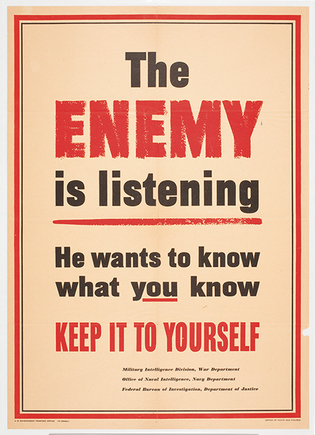 loading
loading
Old YaleThe library at warYale’s library was part of a secret spy mission in World War II. Judith Ann Schiff is chief research archivist at the Yale University Library.  Manuscripts and ArchivesThe Yale Library’s World War II collection owes its existence in part to a US spy operation. A related archive, the War Poster Collection, includes this American poster from 1942. View full imageIn April 1943, Assistant Professor of English Joseph Toy Curtiss ’23, ’26PhD, boarded a ship to begin a three-month journey to Istanbul, where, thanks to a $25,000 gift from an anonymous group of alumni, he was to spend a year acquiring books and other war-related materials for Yale and other libraries. That was the story. In fact, the acquisition work was cover for a spy mission known as the Library Project. Curtiss had been recruited by the Office of Strategic Services (forerunner of the CIA) to gather intelligence on the Axis powers. Curtiss managed to work as a spy and make good on his cover story, sending home two tons of printed material to Yale and other libraries.
Well before Germany and Japan declared war against the US in 1941, Yale had begun collecting documentation of the “European war,” creating the Yale Collection of War Literature in 1940. As publications of the enemy and of occupied countries became increasingly scarce in America, the policy expanded. “The war is all-pervasive in current printed matter; there is no catalogue that does not refer to war, no corporation report that does not mention it, no advertisement that is not influenced by it,” wrote Russell Godine Pruden, Class of 1906, a curator of the collection. “The written word of the war is the written word of man’s life during the war years. Such a collection cannot now be complete nor can it ever be so. The Library is securing this material while it is to be had.” In 1942, Donald Downes ’35 read an item in the Yale Library Gazette encouraging readers to donate war-related material to the collection. As the late Yale professor Robin Winks recounted in his book Cloak and Gown: Scholars in the Secret War, 1939–1961, Yale’s connections to the new intelligence service ran deep: Downes was an OSS officer. He formed the plan to use the collection project as cover to get a spy into Europe. Besides Curtiss himself, the only people at Yale who knew his undercover mission were Pruden and history professor Thomas Mendenhall ’32, ’38PhD, the collection’s curators. Even President Charles Seymour ’08, ’11PhD, was left in the dark. The OSS sent $25,000 to Walter L. Pforzheimer ’35, ’38LLB, a trustee of the Yale Library Associates, who laundered it by presenting it to Yale as a gift to the War Collection from a group of alumni who wished to remain anonymous. Two sets of accounts for the project were set up—one for Yale’s eyes and another for the OSS. As other libraries learned about the collecting program, they insisted on joining, forming the Associated Libraries Group and contributing to the fund. Curtiss collected material from Turkey for the libraries until his intelligence duties began to occupy all his time, at which point the collection work was delegated to a junior OSS officer. Many Yale alumni at other scholarly institutions assisted him and formed related library collecting programs. Among them were Archibald MacLeish ’15, who served as Librarian of Congress from 1939 to 1944; and Wilmarth S. Lewis ’20, who began in Research and Analysis and moved to the Library of Congress, where he and others developed the cooperative collecting of foreign publications by American libraries.
After V-E day, Curtiss again devoted himself to collecting for the libraries. He returned to Yale in the summer of 1946 and taught for another 20 years. The Library Project remained a secret until 1953. Meanwhile, the Yale War Collection grew. Ephemera, manuscripts, pictorial material, and memorabilia form the World War II Collection, held in the Manuscripts and Archives division of Sterling Memorial Library. Additions have continued and provide remarkable documentation for new generations of researchers. A companion compilation—the Yale in World War II Collection—includes leaflets addressed to Japanese soldiers informing them how to surrender, warnings to civilians in combat areas of approaching attacks, psychological warfare flyers, and letters from former Yale students to Yale faculty and staff describing their experiences at military bases in the United States and while serving abroad.
The comment period has expired.
|
|